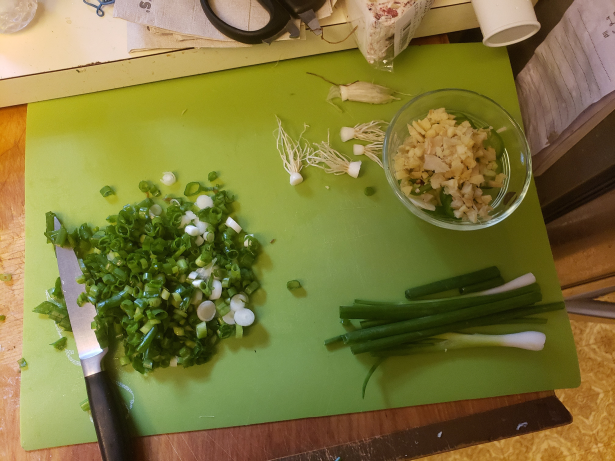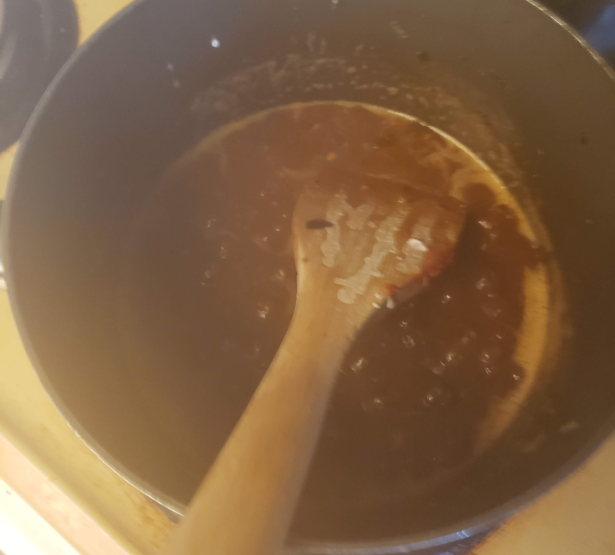KC 179 - Mapo Tofu

Why hello there! And welcome back to Kitchen Catastrophes, where we are just in a heck of a mess today. As you might recall, last week Jon was blown completely off schedule by dental work, and this week, he had a reunion with some of his oldest friends that prevented him from getting the post out on time. And during said reunion, he became more sunburn than man, pink and sensitive, and also dropped his phone into a river. So it’s a great time for him to reflect on the simpler times of making Sichaun food for his family, and them…reacting to it. If you want to skip the history and hysterics, jump straight to the recipe here. For everyone else, let’s get into one heck of a mess.
It’s important, with Grandmothers, to distinguish between “Pocks” and “Pox”
My constant habit of using titles for jokes I haven’t given you the means to comprehend yet continues un contained, you’ll be happy to know.
Anyway, Mapo Tofu, for those unaware of it, is a Sichuan dish consisting of Tofu briefly simmered in a meaty sauce of spicy ground meat (or mushrooms). The name literally translates as “Pock-Marked Grandmother’s Tofu”, as mapo is…something I’ve never seen in Chinese before ( and can’t even recall seeing in formal English, offhand): an elided compound. Ellision, as I think we’ve mentioned before, is when you delete syllables out of a word, or words out of a sentence .So shortening “luncheon” to “lunch” is a form of elision. As is calling someone “bro”, since it’s shortened “brother”.
Now we’re PLURALIZING Ellisions?
Mapo is apparently an elision of mázi pópo, or “Pock-Marked Grandmother”. So instead of saying “pock-marked grandmother” every time, people just called her…basically “Pock-Ma”. Which sounds weird to us, but I mean, if I said I was heading out to eat with my lunchbros, you’d get pretty intuitively what I meant. You might mock me using the phrase, or want to know who they are, but you wouldn’t be confused.
Thus, this kind older woman with facial scarring and RUDE CUSTOMERS made a particularly enjoyable form of simmered tofu, and it became popular. So popular, in fact, that some consider it not just an iconic dish of Sichuan cuisine, but of Chinese cuisine in general. Look up “Sichuan signature dishes”, and it’s in the top 5, every time. Often number 1.
This is because it’s a great dish in Sichuan kitchen to vary your là levels to the audience. Which, in case you forgot, we’ll quickly cover: two of the pillars of Sichuan cuisine (though some may consider them a joined single pillar) are má là, which translates to “numbing spicy”. Specifically, it’s “numbing” and “spicy”. Má is “numbing”, referring to the unique numb-tingle of Szechuan Peppercorns, and Là, refers to chemical heat, what gastronomers call “pungency”. So, in short, you can make the spicy, meaty sauce as spicy as you like. (Spoilers: I don’t)
Now, my recipe is heavily Americanized: true mapo tofu (or, as it’s sometimes written, doufu because, as we’ve noted, Romanizing Asian script is a heck of a process) uses a lot of specific ingredients, and a fair bit of peppers, and this is a weeknight recipe from Bon Appetit, so we’re going with “what can be bought at higher-end American grocery stores”. So, like, instead of China’s “Heaven-Facing Pepper”, we have jalapeño. Instead of real doubanjiang, we have “Garlic Black Bean Sauce” from Lee Kum
It was actually Kikkoman brand. Which…feels like a problem, but I guess isn’t?
I preface the recipe with this warning because last time we covered a Sichuan dish, I was directly contacted by a friend who spent several years teaching in China, who took me to task for my formulation, so I just want to get ahead of it, and say “this is a quick version of Americanized Mapo Tofu”, so that I don’t get mean messages calling me a “trash monster”. (Which I already get, but at least those are because I’m shit at Rainbow Six Siege, not because of my noodle skills)
So let’s get to the dish, and see how you feel when the là gets má.
Turn up the HEAT
So, the first step to the recipe is TECHNICALLY to brown some pork, in a real way that I’m excited to cover, but the REAL first step is, as with all recipes, is forming the mise en place, to jump to a completely DIFFERENT language. Which means dicing all the things you need to have diced, chopping the things you need chopped. One of the big ones for that in this recipe is you need to drain your tofu; which means you just place the brick of tofu on a plate, under another plate, with a weight on top. This squeezes out some of the liquid, so your tofu doesn’t discolor the sauce or weaken the flavor of the final dish. While that’s getting squeezed, you gotta prep your aromatics. Ginger, scallions, jalapeño, garlic. The garlic and jalapeño you slice, the ginger and scallions you chop.
The unglamorous prep work.
THEN you brown the pork. And this is one of my go-to pet peeves: when a recipe says to brown meat, your meat should hit an actual shade of BROWN. This recipe goes super-hardcore about it, as the instructions are literally to add in the pork, and then NOT TOUCH IT for 5 minutes, so it gets super browned and crispy. Because my family stove is 30 years old, the results aren’t as amazing as they could be, but they are at least ACTUALLY BROWN.
That color there? That’s important.
From there, it’s basically a dump recipe. Get the pork browned, toss it around to get it fully cooked, and then add in the aromatics. There’s a precise order, but I’m watchin g Youtube videos at the moment, so you’ll have to wait to the recipe to get those details. I’m just trying to build some suspense here. The result is pretty beautiful in my opinion. It looks basically like a stir-fry.
Or like a really weird hash, I suppose.
From there, we go in a more stew-based direction: drop in some tomato paste, the ground Szechuan peppercorns, and toast them a little bit to get the tomato paste more umami-rich, and to wake up the oils of the peppercorns.
Then, you add in the broth, and doubanjiang, which is a fermented black-bean paste used in several Chinese regions’ cuisine. It’s fairly comparable to the Korean sauce of doenjang, which is a less spicy version of my oft-referenced sauce gochujang. Interestingly, Sichuan style doubanjiang has more chilis and spice to it than most regions’, so maybe gochujang would be a solid stand-in. The resulting mixture is pretty red in color.
Well, Reddish-Brown.
Then, once you get it up to a simmer, it’s time to get THICC. Sorry, internet got in my brain. It’s time to thicken the sauce, by adding a cornstarch slurry. Whisk together the tablespoon of cornstarch with a tablespoon of warm water, and drizzle into the sauce, stirring to incorporate. Let it cook for 1-2 minutes to thicken on, and then get your tofu on. Chop your tofu, pour off the drained liquid, and plop it in. Now, you don’t want to stir the soup too much, or really at all once the tofu gets in, because we’re using silken tofu, so it’ll just shred into paste If stirred too much.
And it’s really just going to sit in here long enough to get some color and flavor infused into it, and then it’s ready to go! Ladle up the tofu and pork sauce, and serve over rice, topped with more chopped scallion. Unfortunately, I was busy making the Mapo Tofu, so no one made rice, and our pre-made “ready in 1 minute” rice expired October 2018, so we decided it probably wasn’t something we wanted to eat. So normally there’d be a starch to soak up the sauce, but we were a little wetter.
Shining, Shimmering, Pork-sauced.
And the result was…well, it was a let-down. For me, and the rest of the family, but I’m the more important part. Not because my opinion matters more than theirs, but because as our Dan Dan Noodle post noted, Nate and Mom did NOT like the effects of Szechuan peppercorns straight. They were okay with them in the chili oil, so we thought they might work here, but no such luck. It appears I’m the only member of my family who likes má. But for ME, the má needed more là: this dish wasn’t NEARLY spicy enough, with only one jalapeño and some garlic paste. I think there’s potential to it, and I’d definitely look at increasing its potency with more chili oil, maybe some more minced peppers or chili flakes, etc. Bu as it was, I was the ONLY member of the group to finish their bowl, and I declined cleaning up either of the others’.
I am, however, definitely still interested in exploring Sichuan cuisine, and more types of mapo tofu, in the future. The Dan Dan noodles were still a huge hit with me, and this dish only failed with an imbalance of flavors, so we can grow into it.
THURSDAY: JON DISCUSSES SICHUAN FOOD MORE DEEPLY, PROBABLY. LOOK, HE’S BASICALLY SUFFERING MILD HEAT STROKE, HE DOESN’T UNDERSTAND ANYTHING.
MONDAY: WE GO INDIAN, FOR…MAYBE THE FIRST TIME ON THE SITE? I HAVE TO CHECK THAT. NO, WAIT, WE DID MANGO LASSI. AT LEAST TWICE.
Get us a bowl of this
Recipe
Quick Mapo Tofu
INGREDIENTS
2 tbsp vegetable oil
8 oz ground pork
1 jalapeño, thinly sliced* (add more for desired heat
4 garlic cloves, sliced
1 1½” piece ginger, peeled and finely chopped
4 scallions, chopped, + more for serving
1 tbsp tomato paste
1 tsp ground Sichuan peppercorns or freshly ground black pepper
2 cups low-sodium chicken broth
3 tbsps doubanjiang, or Chinese black bean garlic sauce (increase if desired)
1 tbsp cornstarch
1 lb silken tofu, drained, cut into 1-inch pieces
steamed white rice (for serving)
Preparation
Heat the oil over medium-high heat in a solid, large saucepan. Add pork and cook without stirring or touching for 5 minutes.
Break up the browned pork, and cook an additional 3 minutes, until browned all over. Add jalapeño, garlic, ginger, and chopped scallions. Cook with the pork for about 3 minutes.
Add the tomato paste and Szechuan peppercorns, and cook for another minute, stirring constantly, for about 1 minute.
Add the broth and sauce, and bring to a simmer. Whisk cornstarch and 1 tbsp warm water into a slurry in a small bowl, and pour into the sauce. Cook an additional minute to thicken.
Add tofu, cover, and let simmer until tofu is heated through
Divide into bowls over rice, and top with scallions.












